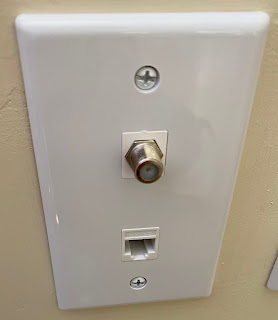Welcome back. Last time I finished sorting out all my old Cat5 cable. Now I know where all the cables go, and I know that all the Cat5 cables are usable for Ethernet. I crimped an RJ45 connector to the ends of each cable. But right now it is all just "dark wire" sitting in the walls. I need to start finishing something.
I removed the old wallplates when I added on the RJ45 connector to each Cat5 cable, but I won't be able to reuse them because my goal is Ethernet. My old wallplates have the telephone style "RJ11" jacks, and most of those wall plates also have a Coax TV cable. They're going to be RJ11-style plates forever, so I put them in my box of "old outlets".
And remember I also need a Coax outlet in each of my wallplates for the TV wires.
Keystone Wallplates
Since the vast majority of my outlets will have Ethernet and Cable TV, I bought a number of 2-hole keystone plates. I also purchased a 10-pack of of Ethernet keystone couplers. The couplers allow me to just plug my in-wall Ethernet cable into the keystone, without having to hook up each wire individually.
In order to finish my outlets I also bought a set of Coax keystones, and a set of blank keystones for when I would otherwise have an empty hole in my wallplate.
I went with all white, but if I add "special" Ethernet ports later (like higher speed ports or something), I'll use a different color.
Installing the plates was easy. I found this the best way:
- Snap the Ethernet Coupler Keystone into bottom position of the plate. (My aesthetic design is Cable TV on top, Ethernet on the bottom).
- Screw the Coax Keystone into the Cable TV coming out of the wall.
- Snap the Coax Keystone into the top position of the plate
- Click in the Ethernet cable coming out of the wall
- Gently tuck all the cables back
- Screw the plate into the wall.
This made for each and quick work, and the results look fantastic!
Next Up...
Next time, I'm really going to deal with all those Cable TV cables... which ones work, which ones are broken, and which of the crazy bundle in the basement goes to which room?
